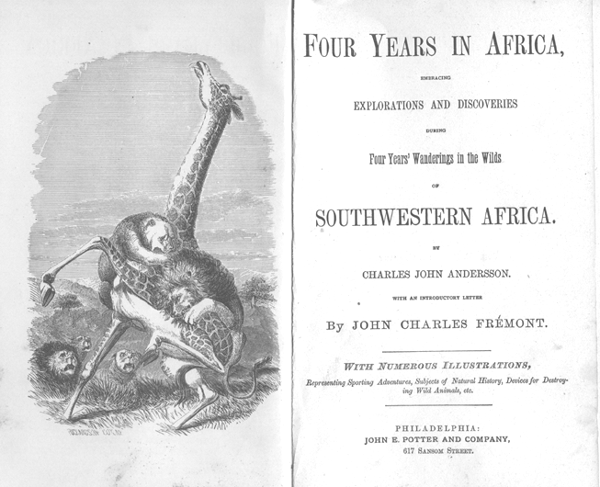Charles John Andersson
The Swedish/English, amateur naturalist, Charles Andersson accompanied Galton on his exploration of South West Africa, and Galton speaks highly of him in Travels in South Africa. Andersson was the illegitimate son of Llewellyn Lloyd, impoverished but of good family, and a Swedish servant. Lloyd published some notable books on the sport and wildlife of Sweden.
Anderson describes his introduction to Galton as follows:
"Shortly after my arrival in London, Sir Hyde Parker, another valued friend of mine, and "The King of Fishermen," introduced me to Mr. Francis Galton, who was then just on the point of undertaking an expedition to Southern Africa; his intention being to explore the unknown regions beyond the boundary of the Cape-of-Good-Hope Colony, and to penetrate, if' possible, to the recently-discovered Lake Ngami. Upon finding that I, also, had an intention of traveling, and that our tastes and pursuits were, in many respects, similar, he proposed to me to give up my talked-of trip to the far north, and accompany him to the southward--promising, at the same time, to pay the whole of' my expenses. This offer awoke within me all my former ambition; and, although I could not be blind to the difficulties and dangers that must necessarily attend such an expedition, I embraced, after some hesitation, Mr. Galton's tempting and liberal proposal." [Four Years in Africa, p. 3]
After Galton returned home, Andersson stayed in the region and conducted further expeditions of his own, reaching the Okavango and the Cunene. His account of the Ovampoland expedition was published in his book Four Years in Africa, usefully supplementing Galton's own account. He also published several other works, including Notes of Travel in South-Western Africa (1875), edited and issued after his death by his father, Llewellyn Lloyd.

Charles John Andersson
1827-1867
Andersson ultimately launched several ventures in Damaraland, including a copper mining scheme. He was briefly elected Chief of the Damara in 1864, but he was severely wounded in battle against the Nama Hottentots. He died there in 1867, and is considered the most important early European explorer of the region.
Andersson repeatedly tried to borrow money from Galton while in London, attempting to find a publisher for his book, but Galton curtly refused, as the following letter from Galton to Anderson shows:"I for my part cannot help you in the way you wish. I have nothing like fortune sufficient to do so. If you had struggled hard with a scrupulous economy, and if as Sir James Brooke did, you had even worked your passage home like a common sailor, if you had lived thriftily and frugally determining to keep as much as possible of what you had so well earned in order to win more, the world would have respected you the more highly. The example you would have set the world would have been a noble one, but a fatal pride has made you take another course and placed you, as I am sure you must acknowledge in a very false position. We all of us make our mistakes in life. The true plan is to use faults as lessons to make us wiser?"
Galton did, however, recommend him to the Royal Geographical Society, which presented him with some scientific instruments.

The cover of an American edition of Andersson's book, replete with an American log cabin and misspelled author ("Anderson").

Bibliography of Charles John Andersson
- Andersson, Charles J. "Explorations in South Africa, with the Route from Walfisch Bay to Lake Ngami", Journal of the Royal Geographical Society, 25 (1855), pp. 79-107.
- Andersson, Charles J. Lake Ngami, or Explorations and Discoveries in the Wilds of Southern Africa. New York, 1856.
- Andersson, Charles J. The Okavango River, a Narrative of Travel, Exploration and Adventure. London, 1861.
- Andersson, Charles J. The Lion and The Elephant (L. Lloyd ed.). London, 1873.
- Andersson, Charles J. Notes of Travel in South-Western Africa New York 1875
- Andersson, Charles J. The Matchless Copper Mine in 1857: Correspondence of Manager C. J. Andersson, edited by Brigitte Lau. Windhoek: National Archives, SWA/Namibia, 1987. 113p., il., maps. ([Archeia, Nr. 7]) .
- Andersson, Charles J. Trade and Politics in Central Namibia 1860-1864: Diaries and Correspondence. Windhoek: Archives Services Division, Dept. of National Education, 1989. 338p., il., maps ([Archeia, Nr. 10]) .
- Wallis, J.P.R. Fortune my Foe: The Story of Charles John Andersson,
African Explorer 1827-1867 (foreword by the Rt. Hon. General J. C. Smuts),
Jonathan Cape, London, 1936